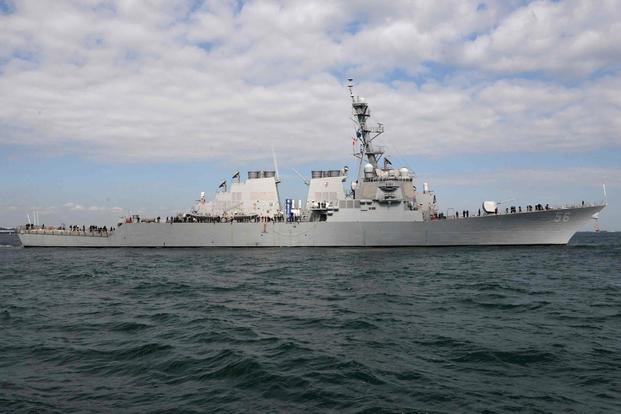Each time Cmdr. Ryan Easterday boards the destroyer John McCain in Japan, he passes a plaque honoring the 10 sailors who lost their lives on the ship nearly three years ago.
Now Easterday, the guided-missile destroyer's commanding officer, is preparing to lead a nearly all-new crew back out to sea aboard one of two Navy ships that experienced fatal 2017 collisions in the Pacific. The McCain completed its basic phase certification this month, which means it can -- for the first time since the Aug. 21, 2017, accident near Singapore -- be tasked for work in the Asia-Pacific region.
"There are still a few old-timers around, all volunteers, who decided they want to stick it out and see the ship back out to sea," Easterday told reporters on Monday. "It's been a pretty intense experience for most of them, I think."
Read Next: Contractor Accused of Providing Faulty Steel for Navy Submarines to Pay $10.9M Settlement
It's a significant milestone for the Navy, which has in recent years suffered -- as the new Navy Secretary Kenneth Braithwaite recently put it -- "a breakdown in the trust of those leading the service."
The guided-missile destroyer Fitzgerald, which weeks before the McCain's accident was involved in a separate deadly collision off the coast of Japan, left a Mississippi shipyard this weekend to head to its new homeport in San Diego.
The McCain's crew has spent the last 25 weeks completing extensive training after years' worth of repairs and maintenance to get the ship up and running again. The crew was evaluated in 23 areas, including several the Navy found needed serious improvement after the back-to-back 2017 collisions.
"The John McCain is one of the first ships to benefit from these changes," Easterday said, "including revised individual and unit training, updated career paths and practices, and renewed focus on professional seamanship and navigation."
The McCain, like other ships, will also have a "circadian watch bill onboard," Easterday said, to ensure the crew is getting enough rest -- a big shortfall identified in the investigations into the 2017 ship collisions.
The Navy also overhauled its ship navigation training after the accidents, significantly ramping up the amount of time sailors spend in simulators before getting to ships. The way the Navy trained officers and sailors to operate at sea, much of which was previously done through distance learning, came under intense scrutiny following the McCain and Fitzgerald collisions.
Before the crew even started their basic phase, they had more than 200 hours of simulated training, Easterday said. Using the high-tech Navigation, Seamanship and Shiphandling Trainer, Easterday said the McCain crew was able to practice underway replenishments and high-traffic scenarios.
Investigators found one primary cause of the McCain's collision was "leaderships' loss of situational awareness in a high-traffic area."
"It's a great opportunity for individuals, mostly junior officers who are learning to be officers of the deck or trying to maintain proficiencies, to practice special evolutions that we don't do very often," Easterday said.
Before it was certified to rejoin the fleet, the McCain's crew faced a high-stress test to ensure it was ready to rejoin the fleet.
"We actually destroyed the bridge," Easterday said. "We put a smoke machine up there and posed a bunch of personnel casualties, which forced the damage control organization to figure out how to fight the fire up there -- a place that you don't normally find a fire."
The first-aid team had to deal with casualties while the watch teams had to regain control of the ship from alternate stations, he said. The combat information center watch team had to take over ship driving and navigation -- all while still fighting a combat scenario, Easterday said.
"It really is designed to put people under stress and make them think through and prioritize what they've got to do next to solve these problems in real time," he said.
Easterday, who became the ship's executive officer soon after the McCain's former top officers were relieved following the collision, said he's proud of his crew and is confident they'll be able to carry out any mission they're called on to complete.
Everything the McCain crew has done in the last three years is in honor of the 10 men who died in the 2017 collision, he added.
"Our successes are their legacy," Easterday said. "I'm absolutely confident in saying that Big Bad John is back, and we are more ready and more lethal than ever before."
-- Gina Harkins can be reached at gina.harkins@military.com. Follow her on Twitter @ginaaharkins.
Related: New Report Points to Acute Fatigue as Factor in Deadly Navy Ship Collision













